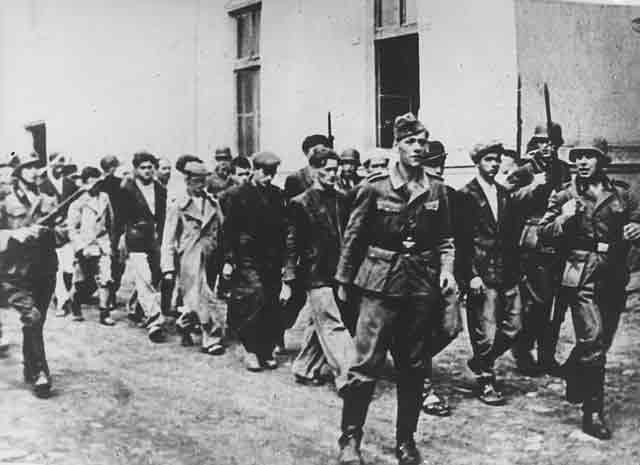Saturday 13 September 1941
 |
| Georgy Zhukov. |
Eastern Front: Throughout World War II, the Germans learn certain "tells" about Soviet intentions. For instance, when Soviet units suddenly stop using their radios and "go dark" in a certain sector, that invariably means they are about to launch an offensive there. Every army has such tendencies, though some are more subtle than others.
The presence of General (later Marshal) Georgy Zhukov in a sector was such a "tell." Zhukov was a close Stalin confidante and the hero of, among other things, the victory over the Japanese at Khalkin Gol in Manchukuo/Mongolia in August 1939. Whether or not Zhukov was a military genius, which he apparently was, he had Stalin's absolute backing and could count on whatever resources he required to achieve his ends. For the Germans, it was an ominous indication that the Soviets placed great importance on whatever was planned for that area.
 |
| U.S. Navy Douglas TBD-1 Devastator aircraft of Torpedo Squadron 5 (VT-5) parked at Naval Air Station Norfolk, Virginia (USA), on 13 September 1941. Beyond them are Douglas SBD-3 Dauntless planes of Bombing Squadron 5 (VB-5), with Grumman F4F Wildcat fighters and Vought SB2U Vindicator scout bombers further in the left background. These aircraft are from USS Yorktown (CV-5) (Official U.S. Navy photo 80-CF-55215-7 from the U.S. Navy Naval History and Heritage Command, US National Archives). |
On
13 September 1941, Zhukhov flies into besieged Leningrad along with Major-Generals Ivan Ivanovich Fediuninsky and Mikhail Semenovich Khozin. As soon as he steps off the plane, Zhukov walks over to Marshal Kliment Voroshilov, himself one of the top Soviet commanders, and hands him a note from Stalin. It names Zhukov as Voroshilov's replacement:
Hand over the Front to him and come back by the same plane. Stalin.
And that was it. Zhukov was in command at Leningrad.
For the garrison of Leningrad, Zhukov arrives like the first icy winds of winter. He institutes the death penalty for dereliction of duty, orders immediate costly but effective counterattacks, and brings the scattered military and civilian forces available for the defense under a tight grip.
Zhukov sends General Fedyuninsky to the headquarters of the 42nd Army. Fedyuninsky finds General Ivanov, commander of the army, "sitting with his head in his hands, unable to even point out the location of his troops." Fedyuninsky reports this to Zhukov, who replies, "Take over the 42nd Army - and quick."
 |
| A German diver getting into the water to clear water from the harbor at Reval (Tallinn), the capital of Estonia (Dumm, Federal Archives Bild 146-2004-225). |
Meanwhile, the Germans are still pressing in on Leningrad. Army Group North commander Field Marshal von Leeb is under orders to sends his panzer divisions south for the attack on Moscow, but he uses them today to tighten the grip on Leningrad. General George-Hans Reinhardt’s XLI corps (1st and 6th Panzer and 36th Motorized Divisions) and General Wilhelm von Chappius' 38th Army Corps (1st, 58th, 254th, and 291st Infantry Divisions) break through the Soviet line north of Krasnoe Sela. L Army Corps takes Krasnogvardiesk in conjunction with Reinhardt's troops.
While von Leeb does advance a bit closer to Leningrad, this does not really accomplish much. He has been ordered to blockade the city, not take it, and he already has done that. Von Leeb already is under orders to relinquish the panzers and send them south for the drive on Moscow. Small gains on the city's outskirts mean little. Using the armor in fierce attacks causes losses and wear and tear, and the panzers are already in bad shape after having had little downtime since Operation Barbarossa began on 22 June 1941. Thus, for no real benefit, von Leeb impairs the effectiveness of armor that might make a difference in the advance planned toward Moscow. This is typical behavior for the German generals, who tend to focus on their own army's affairs at the expense of the greater good of the German war effort.
Battle of the Baltic: Finnish capital ship Ilmarinen, participating in Operation Nordwind, hits a mine and sinks. There are 271 casualties or 7% of the entire Finnish naval arm. It is the costliest loss in the history of the Finnish Navy.
German Military: Luftwaffe ace Werner Mölders marries Luise Baldauf.
 |
| The wedding ceremony of Werner Mölders and Luise Baldauf. This is her second marriage, and she will give birth to their daughter Verena following his death in November. Luise passed away on 21 April 2011. |
September 1941
September 1, 1941: Two Years InSeptember 2, 1941: Germans Pushed Back at YelnyaSeptember 3, 1941: FDR Refuses to Meet with JapaneseSeptember 4, 1941: Hitler Furious at GuderianSeptember 5, 1941: Germans Evacuate YelnyaSeptember 6, 1941: Japan Prepares for WarSeptember 7, 1941: Hitler Orders Drive on MoscowSeptember 8, 1941: Leningrad Cut OffSeptember 9, 1941: Germans Attack LeningradSeptember 10, 1941: Guderian Busts LooseSeptember 11, 1941: Convoy SC-42 DestructionSeptember 12, 1941: Starve Leningrad!September 13, 1941: Zhukov at LeningradSeptember 14, 1941: Germany's Growing CasualtiesSeptember 15, 1941: Sorge Warns Stalin AgainSeptember 16, 1941: Soviets Encircled at KievSeptember 17, 1941: Iran Conquest CompletedSeptember 18, 1941: Focke-Wulf Fw 190 in ActionSeptember 19, 1941: Germans Take KievSeptember 20, 1941: Death at KievSeptember 21, 1941: Raging Soviet ParanoiaSeptember 22, 1941: Defense of Nickel MinesSeptember 23, 1941: Air Attacks on LeningradSeptember 24, 1941: Japanese Spying IntensifiesSeptember 25, 1941: Manstein at the CrimeaSeptember 26, 1941: Kiev Pocket EliminatedSeptember 27, 1941: Massacre at EišiškėsSeptember 28, 1941: Ted Williams Hits .400September 29, 1941: Babi Yar MassacreSeptember 30, 1941: Operation Typhoon Begins2020

















